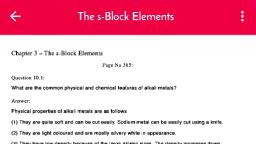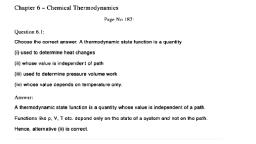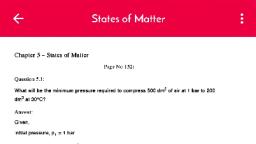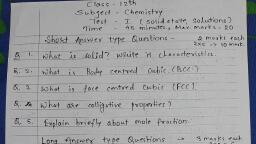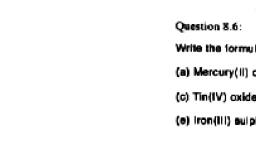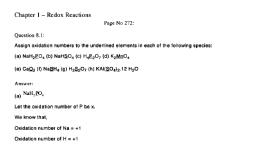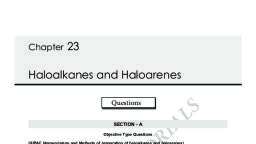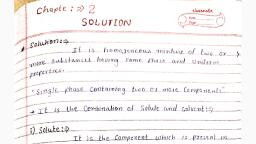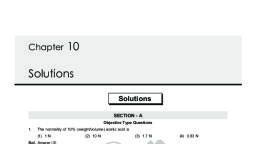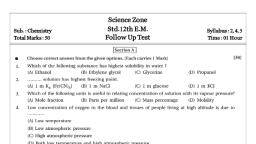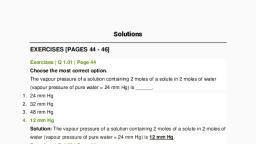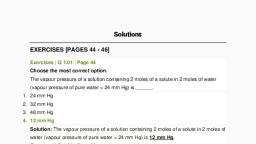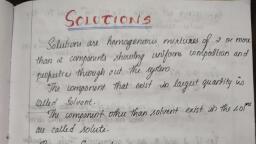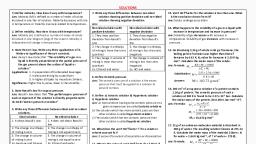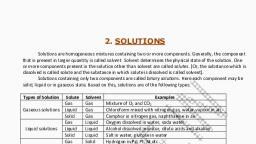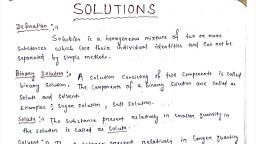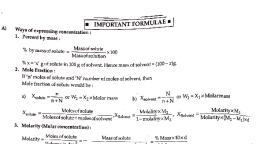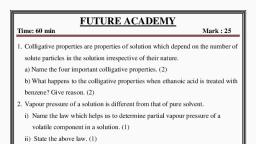Page 1 :
Chapter, , 10, , Solutions, , LS, , Questions, SECTION - A, , TO, RI, A, , Objective Type Questions, (Binary Solution, Concentration Terms, Solubility), 1., , The normality of 10% (weight/volume) acetic acid is, (1) 1 N, , (2) 10 N, , (3) 1.7 N, , Sol. Answer (3), , ⎛w⎞, 10% ⎜ ⎟ 10 g CH3COOH in 100 mL of solution., ⎝V⎠, , (4) 0.83 N, , TU, , CH3 COOH = 24 + 4 + 32, , 10 1000, w, 1, N = M × n-factor , n =, 60 100, Mw V(L), , ⇒ 60 g, n-factor = 1 (CH3 COOH), , 2., , GA, LA, XY, , N = 1.66 nearest option is (3), , 20 ml of 0.5 M HCl is mixed with 30 ml of 0.3 M HCl the molarity of resulting solution is, , (1) 0.8 M, , (2) 0.53 M, , (3) 0.38 M, , (4) 0.83 M, , Sol. Answer (3), , M1V1 + M2V2 = M3V3, , 0.5 × 20 + 0.3 × 30 = M3[V1 + V2], M3 =, , 10 + 9 = M3[20 + 30],, , 3., , 19, = 0.38, 50, , 20 ml of 0.2 M Al2(SO4)3 is mixed with 20 ml of 6.6 M BaCl2, the concentration of Cl– ion in solution is, , (1) 0.2 M, , (2) 6.6 M, , (3) 0.02 M, , (4) 0.06 M, , Sol. Answer (2), BaCl2 , 6.6 M, , Ba2+, , +, , 6.6 M, , 2Cl–, 2 × 6.6 Initial molarity of Cl–, , V1 of (Cl–) = 20 mL, , So, M1V1 = M2V2, 2 × 6.6 × 20 = M2 × [20 + 20] Mixed with 20 mL of Al2(SO4)3, M2 , , It increases volume but can't effect concen–, –, tration of Cl because it does not have Cl, , 2 6.6 20, = 6.6, 40, , An Innovative Institute in Raipur (C.G) for IIT-JEE, NEET & 9 Std.- 12 Std.(PCM & PCB). Cont. @ 919993551234, 918770887703
Page 2 :
38, 4., , Solutions, , The expression relating molarity (M) of a solution with its molality (m) is, (where d = density, MB mol. wt. of solute), , 1000 M, 1000d M MB, Sol. Answer (2), , (2) m , , (1) m , , m, , (3) m , , 1000d MMB, 1000 M, , 1000d – MMB, 1000 M, , 1000 M, 1000 d M MB, , If solubility of any gas in the liquid at 1 bar pressure is 0.05 mol/lit. What will be its solubility at 3 bar pressure,, keeping the temperature constant ?, (1), , 0.05, mol/lit, 3, , (2) 0.15 mol/lit, , (3) 0.05 mol/lit, , (4) 1.0 mol/lit, , AL, , Sol. Answer (2), p = KH × solubility (x), 1 = KH × 0.05, , 1 0.05, , 3, x, x = 0.05 × 3 = 0.15 mol/litre, , TU, TO, RI, , ....(i), , 3 = KH × x, , , , ....(ii), , , , 6., , (4) m , , S, , 5., , 1000 M, 1000d – M MB, , Two solutions of a non-electrolyte are mixed in the following manner. 480 mL of 1.5 M first solution + 520 mL, of 1.2 M second solution. What is the molarity of the final solution?, (1) 1.344 M, , (2) 2.70 M, , Sol. Answer (1), M1V1 + M2V2 = M3V3, , (3) 1.20 M, , (4) 1.50 M, , 7., , 1.5 480 1.2 520 720 624 1344, , , 1.344 M, 480 520, 1000, 1000, , LA, , M3 , , XY, , 1.5 × 480 + 1.2 × 520 = M3 [V1 + V2], , Which of the following statement is true?, (1) Molarity of solution is independent of temperature, , (2) Molality of solution is independent of temperature, , GA, , (3) Mole fraction of solute is dependent on temperature (4) The unit of molality is mol dm–3, , Sol. Answer (2), (1) M , , w, Mw V(L), , M, , 1, Volume, , M – Depends on volume so it also depends on temperature. PV nRT, (2) Molality =, , w, Mw w solvent (kg), , Molality does not depend on volume so it does not depend on temperature., (3) Mole fraction also does not depend on volume, so not on temperature, (4) m , , w, mol ⎛, mol ⎞, , not 3 ⎟, Mw w solvent(kg), kg ⎜⎝, dm ⎠, , An Innovative Institute in Raipur (C.G) for IIT-JEE, NEET & 9 Std.- 12 Std.(PCM & PCB). Cont. @ 919993551234, 918770887703
Page 3 :
Solutions, , 39, , (Vapour Pressure of Liquid Solutions, Ideal and Non-ideal Solutions), 8., , The boiling points of C6H6, CH3OH, C6H5 NH2 and C6H5NO2 are 80oC, 65oC, 184oC and 212oC respectively., Which of the following will have highest vapour pressure at room temperature?, (1) C6H6, , (2) CH3OH, , (3) C6H5NH2, , (4) C6H5NO2, , Sol. Answer (2), , 1, V.P., If B.P. is low means liquid can easily boil so, liquid forms vapours easily - vapours increases = vapour pressure, increases, among all compounds boiling point of CH3OH is min. B.P. = 65ºC so it will have maximum vapour, pressure., B.P. , , S, , The highest temperature at which vapour pressure of any liquid can be measured is, (1) Critical temperature, , (2) Boyle’s temperature, , (3) Boiling point of the liquid, , (4) Kraft temperature, , AL, , 9., , Sol. Answer (3), , TU, TO, RI, , Boiling point of the liquid is the tempreature at which vapour pressure of liquid equals to atmospheric, pressure., 10. If solute and solvent interactions are more than solute-solute and solvent-solvent interactions then, (1) It is ideal solution, , (3) It is non-ideal solution with negative solution, Sol. Answer (3), , (2) It is non-ideal solution with positive deviation, (4) Can't be predicted, , Solute-Solvent interactions > Solute-solute or solvent-solvent interaction, , , XY, , interactions are high, , So, bonds cannot easily break thats why vapours decreases So, V.P. decreases negative deviation., , LA, , 11. Which of the following is correct about a solution showing positive deviation?, (1) Vapour pressure observed will be the less than that calculated from Raoult’s law, (2) Minimum boiling azeotrope will be formed, , GA, , (3) Hmix < 0, , (4) Vmix < 0, , Sol. Answer (2), , In positive deviation solution, , Solute-solvent interactions < Solute-solute or solvent - solvent interaction, , Bond can break easily Vapours increases V.P. increases, V.P. High that's why B.P. = Low min. boiling azeotrope., Hmix > 0, Vmix > 0, , An Innovative Institute in Raipur (C.G) for IIT-JEE, NEET & 9 Std.- 12 Std.(PCM & PCB). Cont. @ 919993551234, 918770887703
Page 4 :
40, , Solutions, , 12. If C2H5OH and H2O solution is example of non-ideal solution then which graphical representation is correct?, , V.P, , V.P, , V.P, , (2), , (1), , (3), , Mole fraction, , Mole fraction, , (4), , Mole fraction, , V.P, Mole fraction, , Sol. Answer (2), C2H5 – OH + H2O solution is an example of negative deviation because they can form H-bond so V.P. decreases of solution., , S, , solution, , TU, TO, RI, , Mole fraction, , AL, , negative deviation from solution, , V.P, , 13. If P° and P are the vapour pressure of solvent and solution n1 and n2 are the moles of solute and solvent then, , ⎛ n2 ⎞, (1) P P ⎜, ⎟, ⎝ n1 n2 ⎠, , ⎛, ⎞, (2) P P ⎜ n2 ⎟, n, , n, 2 ⎠, ⎝ 1, , Sol. Answer (2), , (3) P P ⎛⎜ n1 ⎞⎟, ⎝ n1 n2 ⎠, , (4) Pº = P × n1, , Pº = solvent, , ⎛ n2 ⎞, P = Pº ⎜ n n ⎟, ⎝ 1, 2 ⎠, , n2, Moles of solvent, x = mole fraction of solvent = moles of solute + moles of solvent n n, 1, 2, , XY, , P = Pºx, , 14. Among the following mixtures, dipole-dipole as the major interaction, is present in, , LA, , (1) Benzene and CCl4, , (2) Benzene and C2H5OH, , (3) CH3COCH3 and CH3CN, , GA, , (4) KCl and water, , Sol. Answer (3), , Benzene CCl4, (1) �����������������, non polar not dipole, , (2) Benzene C2H5 OH, , Non polar, , , polar, , (3) CH3 – C – CH3 + CH3 – CN, , O, , Polar covalent, dipole, , Polar covalent, dipole, , dipole-dipole, , H2O, (4) KCl, Ionic, polar, , An Innovative Institute in Raipur (C.G) for IIT-JEE, NEET & 9 Std.- 12 Std.(PCM & PCB). Cont. @ 919993551234, 918770887703
Page 5 :
Solutions, , 41, , 15. For an ideal solution with PA PB , which of the following is true?, (1) A(l) = A(V), , (2) A(l) > A(V), , (3) A(l) < A(V), , (4) No relationship in their mole fraction, , Sol. Answer (3), , PA PB Vapour pressure of (A) is more than (B) so mole fraction of (A) is more in vapour phase than, liquid phase. Because vapours are more formed, A(l) < A(v), 16. An azeotropic solution of two liquids has a boiling point lower than either of the boiling points of the two liquids, when it, (2) Shows positive deviation, , (3) Shows no deviation, , (4) Is unsaturated, , AL, , S, , (1) Shows negative deviation, , Sol. Answer (2), , TU, TO, RI, , Positive deviation shows, minimum B.P. azeotrope, V.P. = High B.P. = minimum, , 17. Equal moles of benzene and toluene are mixed the V.P. of benzene and toluene in pure state are 700 and, 600 mm Hg respectively. The mole fraction of benzene in vapour state is, (1) 0.7, , (2) 0.47, , (3) 0.50, , (4) 0.54, , Sol. Answer (4), , Total moles of benzene and toluene let 1 mole, , Mole fraction of benzene in vapours , , 600, , 1, 2, , GA, , pToluene, , LA, , , pbenzene, 700, , XY, , 1, 1, 1, 1, , Toluene =, Total =, +, =1, 2, 2, 2, 2, , So, benzene =, , benzene , , toluene , , 1 1, , 2 2, , 1, 2, , 1 1, , 2 2, , , , , , 1, 2, , 1, 2, , benzene(g) =, , p benzene, p total, , , p benzene, x benzene, , (P x)benzene (p x)toluene, , 700 , , =, , 1, 2, , 1, 1, 700 600 , 2, 2, , , , 350, 0.53, 350 300, , 18. Calculate the mole fraction of toluene in the vapour phase which is in equilibrium with a solution of benzene, and toluene having a mole fraction of toluene 0.5. (The vapour pressure of pure Benzene is 119 torr and that, of toluene is 37 torr at the same temperature), (1) 0.5, , (2) 0.75, , (3) 0.625, , (4) 0.237, , An Innovative Institute in Raipur (C.G) for IIT-JEE, NEET & 9 Std.- 12 Std.(PCM & PCB). Cont. @ 919993551234, 918770887703
Page 7 :
Solutions, , 43, , 21. In ideal solution of non volatile solute B in solvent A in 2 : 5 molar ratio has vapour pressure 250 mm. If an another, solution in ratio 3 : 4 prepared then vapour pressure above this solution, (1) 200 mm, , (2) 250 mm, , (3) 350 mm, , (4) 400 mm, , Sol. Answer (1), nB 2, , nA 5 ,, , nB 3, , nA 4, , Ps = 250,, , Ps = ?, non-volatile, solute pB = 0, , Ps = pA + pB, , Ps pA px x A, nA, 5, 5, , , nA nB 5 2 7, , ...(i), , xA , , nA, 4, 4, , , nA nB 4 3 7, , ...(ii), , Ps pA , , 4, 7, , ...(iii), , ...(iv), , 5, 7, 4, , Ps p A , 7, 250 5, , Ps, 4, 1, , 2, , 250 pA , , 250 4, 200 mm, 5, , XY, , Ps , , AL, , 5, 7, , TU, TO, RI, , 250 Ps pA , , S, , xA , , (Colligative Properties, Abnormality in Molar Mass), , (1) X, , LA, , 22. The vapour pressure of a solution having 2.0 g of solute X (molar atomic mass = 32 g mol–1) in 100 g of CS2 (vapour, pressure = 854 torr) is 848.9 torr. The molecular formula of the solute is, (2) X2, , (3) X4, , (4) X8, , GA, , Sol. Answer (4), , p p, xA ,, p, (Solute), , xA , , nA, n, � A (For dilute solution), nA nB, nB, , , , 854 848.9 nA WA MB, , , 854, nB MA WB, , ;, , WA = weight of solute, WB = molar mass of solute, , , , 5.1, 2 76, , 854 M A 100, , ;, , MB = molar mass of solvent = CS2 = 12 + 32 × 2 76 g, , MA, , (Molar mass, of solute), , , , 2 76 854, 253, 100 5.1, , molar mass 253, Number of atoms = atomic mass 32 7.90 8, , An Innovative Institute in Raipur (C.G) for IIT-JEE, NEET & 9 Std.- 12 Std.(PCM & PCB). Cont. @ 919993551234, 918770887703
Page 8 :
44, , Solutions, , 23. A pressure cooker reduces cooking time for food because, (1) Cooking involves chemical changes helped by a rise in temperature, (2) Heat is more evenly distributed in the cooking space, (3) Boiling point of water involved in cooking is increased, (4) The higher pressure inside the cooker crushes the food material, Sol. Answer (3), Pressure cooker reduces cooking time for food because B.P. of water involved in cooking is increased due, to which more heat is transferred to food and food can easily cook., , (2) 0.93 atm, , (3) 0.65 atm, , (4) 0.76 atm, , AL, , (1) 0.81 atm, , Sol. Answer (2), , TU, TO, RI, , Osmotic pressure, = CRT, =, , S, , 24. What would be the osmotic pressure at 25°C of an aqueous solution containing 1.95 g of sucrose (C12H22O11), present in 150 ml of solution?, , 1.95 1000, 0.082 298 = 0.93 atm, 342 150, , 25. The vapour pressure of a dilute aqueous solution of glucose is 750 mm Hg at 373 K. Calculate the mole fraction, of solute. (The vapour pressure of pure water is 760 mm Hg at 373 K), (1) 0.013, , (2) 1.3, , Sol. Answer (1), , p p, x A (solute) ,, p, , (3) 0.13, , (4) 1.1, , XY, , 760 750, xA, 750, 10, xA, 750, , LA, , xA = 0.013, , 26. In the case of osmosis, solvent molecules move from solution having, , GA, , (1) Higher vapour pressure to lower vapour pressure, (2) Higher concentration to lower concentration, (3) Lower vapour pressure to higher vapour pressure, (4) Higher osmotic pressure to lower osmotic pressure, , Sol. Answer (1), In osmosis solvent molecules more from their higher concentration to this lower concentration through semi, permeable membrane, i.e.,, , pure solvent, , (Vapour pressure), , S.P.M., solute, low (V.P.), , Of pure solvent is more than solution i.e. more from higher vapour pressure to lower vapour pressure., An Innovative Institute in Raipur (C.G) for IIT-JEE, NEET & 9 Std.- 12 Std.(PCM & PCB). Cont. @ 919993551234, 918770887703
Page 9 :
Solutions, , 45, , 27. Equimolar solution of non-electrolyte in the same solvent have, (1) Same boiling point and same freezing point, (2) Different boiling point and different freezing point, (3) Same boiling point but different freezing point, (4) Same freezing point but different boiling point, Sol. Answer (1), , Tb Tb Tb, , Tf Tf Tf, For same solvent (given), , AL, , S, , Tb = constant, Tf = constant, Tf Tf m, , TU, TO, RI, , So Tb Tb m, m = same (given), , So Tb & Tf also becomes same, , 28. In the phenomenon of osmosis through the semipermeable membrane, (1) Solvent molecules pass from solution to solvent, (2) Solvent molecules pass from solvent to solution, (3) Solute molecules pass from solution to solvent, (4) Solute molecules pass from solvent to solution, , XY, , Sol. Answer (2), , In osmosis solvent molecules pass from solvent to solution through semipermeable membrane, , LA, , 29. The osmotic pressure of 0.1 M sodium chloride solution at 27°C is, (1) 4.0 atm, , (2) 2.46 atm, , (3) 4.92 atm, , (4) 1.23 atm, , GA, , Sol. Answer (3), , = (CST) × i, , , , NaCl Na Cl, (i 2), , –, , T = 273 + 21 = 300, , = (0.1 × 0.0821 × 300) × 2 4.92 atm, , 30. A solution containing 8.6 g L–1 of urea is isotonic with a 5% solution of unknown solute. The molar mass of, the solute will be, (1) 348.9 g mol–1, , (2) 174.5 g mol–1, , (3) 87.3 g mol–1, , (4) 34.89 g mol–1, , Sol. Answer (1), , ⎛ w ⎞, Urea 8.6 g/L = i.e., ⎜, ⎟, ⎝ volume ⎠, Molar mass = NH2CONH2 14 × 2 + 4 + 12 + 16 60, An Innovative Institute in Raipur (C.G) for IIT-JEE, NEET & 9 Std.- 12 Std.(PCM & PCB). Cont. @ 919993551234, 918770887703
Page 10 :
46, , Solutions, , isotonic [1 = 2], C1ST = C2ST, C1 = C2, W, W, , Mw V Mw V, , 8.6, 5 1000, ⇒, 60, Mw 100, Mw , , 5 60 10, 348.8 g / mol, 8.6, , AL, , S, , Errata : 5% solution of unknown solute but it must be written 5% weight/volume means 5 g of solute present, in 100 mL of solution, 31. Which of the following physical properties is used to determine, the molecular mass of a polymer solution?, , (3) Depression in freezing point, Sol. Answer (4), , (2) Elevation in boiling point, , TU, TO, RI, , (1) Relative lowering of vapour pressure, , (4) Osmotic pressure, , In relative lowering of vapour pressure elevation in B.P. depression in freezing point get minimum for high, molecular masses but osmotic pressure can't lowered as much for high mol. masses, 32. In a 0.2 molar aqueous solution of a weak acid HX, the degree of ionization is 0.3. The freezing point of the, solution will be nearest to, (1) 0.48°C, , (2) –0.48°C, , Sol. Answer (2), , (4) –0.26°C, , ⎡Tf (H2O) 0C⎤, ⎢, ⎥, ⎣⎢ K f 1.86 ⎦⎥, , XY, , M = 0.2 (concentration), = 0.3, Tf = ?, , (3) –0.36°C, , , –, ���, �, HX ���, �H X, , 1, , 0, , t = t1, , 1–, , , , 0, , LA, , t=0, , , , GA, , Total moles at, , equilibrium = 1 – + + = 1 + , i, , number of moles after dissociation, initial moles, , i⇒, , 1 , 1, , Tf = i [kf × m], , Tf Tf ⇒ (1 )[1.86 0.2], 0°C – Tf = 1 + 0.3 [1.86 × 0.2], –Tf 1.3 × 1.86 × 0.2, Tf = –0.48°C, An Innovative Institute in Raipur (C.G) for IIT-JEE, NEET & 9 Std.- 12 Std.(PCM & PCB). Cont. @ 919993551234, 918770887703
Page 11 :
Solutions, , 47, , 33. The boiling point of water at 735 torr is 99.07°C. The mass of NaCl added in 100 g water to make its boiling, point 100°C is (kb = 0.51 K kg mol–1), (1) 10.68 g, , (2) 5.34 g, , (3) 2.67 g, , (4) 26.7 g, , Sol. Answer (2), Tb = i(k b × m) i(NaCl = 2 (Na+ + Cl– ), Mw = NaCl = 58.5, , ⎡, ⎤, w 1000, Tb Tb 2 ⎢0.51, ⎥, M w (solvent) k f ⎥⎦, ⎣⎢, , 0.93 , , 0.93 58.5, 54.405, , 5.3 g, 2 0.51 10 2 0.51 10, , 34. If van't Hoff factor, i = 1, then, (1) It is dissociation, , (2) It is association, , (3) Both (1) & (2), , (4) Neither dissociation nor association, , Sol. Answer (4), , number of particles after dissociation association, initial moles, , i > 1 = Dissociation, i < 1 = Association, , XY, , i, , S, , 2 0.51 w 10, 58.5, , TU, TO, RI, , w, , w 1000, 58.5 100, , AL, , 100 – 99.07 2 0.51, , LA, , i = 1 = neither dissociation nor association, , 35. Which of the following equimolar solution have highest vapour pressure?, (1) Glucose, , (3) K2SO4, , (2) NaCl, , (4) K4Fe(CN)6, , GA, , Sol. Answer (1), , Vapour pressure , , 1, number of ions / particles, , Glucose does not dissociate into ions so it, , 1 ⎞, has minimum B.P. so maximum V.P. or ⎛⎜ B.P. , ⎟ i (von' t Hoff factor), V.P., ⎝, ⎠, 36. When NaCl is added to aqueous solution of glucose, (1) Freezing point is lowered, , (2) Freezing point is raised, , (3) Freezing point does not change, , (4) Variation in freezing point can't be predicted, , Sol. Answer (1), NaCl is added to aq. solution then V.P. of solution decrease so freezing point is lowered., An Innovative Institute in Raipur (C.G) for IIT-JEE, NEET & 9 Std.- 12 Std.(PCM & PCB). Cont. @ 919993551234, 918770887703
Page 12 :
48, , Solutions, , 37. If is the degree of dissociation of Na2SO4. The van’t Hoff factor used for the calculation of molecular mass, is, (1) 1 + 2, , (3) 1 + , , (2) 1 – 2, , (4) 1 – , , Sol. Answer (1), Na2SO4 2Na SO4–2, t = 0 (initial), , 1, , 0, , 0, , t = t1, , 1–, , 2, , , , i, , 1– 2 , ⇒ 1 2, 1, , S, , 38. The relationship between the values of osmotic pressure of 0.1M solutions of KNO3(P1) and CH3COOH(P2) is, (2) P2 > P1, , (3) P1 = P2, , TU, TO, RI, , Sol. Answer (1), , P1, P2, (4) P P P 2P, 1, 2, 1, 2, , AL, , (1) P1 > P2, , = i(CRT), If C, T = constant, i, , For KNO3 (i) greater than CH3COOH because CH3COOH is a weak acid which shows less dissociation, and KNO3 shows more dissociation thats why its (i) increases so of KNO3 is more., 39. The relationship between osmotic pressure (P) at 273 K when 10 g glucose (P1), 10 g urea (P2) and 10 g, sucrose (P3) are dissolved in 250 ml of water is, (1) P1 > P2 > P3, = i(CRT), , (3) P2 > P3 > P1, , (4) P3 > P2 > P1, , XY, , Sol. Answer (2), , (2) P2 > P1 > P3, , all are non-electrolytes (i = 1), , LA, , ⎛n, ⎞, i ⎜ RT ⎟, ⎝V, ⎠, , w, So, Molar mass, , GA, , R = constant, , T = Constant, , , , 1, Molar mass, , W = 10 g = constant, i = non-electrolyte = 1, Glucose, Urea, C6H12O6, NH2CONH2, Molar Mass 180, 60, P1, P2, , Sucrose, C12H22O11, 342, P3, , ⎡Molar mass Sucrose Glucos e urea, now ⎢ P P P, 2, 1, 3, ⎣, An Innovative Institute in Raipur (C.G) for IIT-JEE, NEET & 9 Std.- 12 Std.(PCM & PCB). Cont. @ 919993551234, 918770887703
Page 13 :
Solutions, , 49, , 40. What is the molality of C 2 H 5 OH in water solution which will freeze at –10 o C? [Mol. wt. of, C2H5OH = 46, Kf for water = 1.86], (1) 6.315 m, , (2) 63.15 m, , (3) 3.540 m, , (4) 5.3 m, , Sol. Answer (4), Tf = i(kf × m), , i = C2H5OH non-electrolyte = 1, , 0 –(–10) = 1(1.86 × m), , Tf Tf Tf, , m, , 10, ⇒ 5.3, 1.86, , Tf of water = 0°C, , , , 41. Which of the following pairs of solutions can we expect to be isotonic at the same temperature?, (2) 0.1 M urea and 0.1 M NaCl, , (3) 0.1 M urea and 0.2 M MgCl2, , (4) 0.1 M Ca(NO3)2 and 0.1 M Na2SO4, , AL, , S, , (1) 0.1 M NaCl and 0.1 M Na2SO4, Sol. Answer (4), = iCRT, , (1) NaCl i = 2 (Na+ + Cl–), , TU, TO, RI, , when i, C, T are same for two or more than two solutions then their osmotic pressure are also same that, are known as isotonic, , Na2SO4 2Na SO4–2 i 3 different so not isotonic, (2) Urea i = 1 non-electrolyte ⎤, ⎥ different so not isotonic, NaCl i = 2 [Na+ + Cl– ] ⎦, , Urea i = 1, , (3), , 2+, , (4), , XY, , MgCl2 i = 3 [Mg, , ⎤, ⎥ different so not isotonic, + 2Cl ]⎥⎦, –, , Ca(NO3 )2 Ca2 2NO3–, Na2 (SO4 ) 2Na, , , , SO4–2, , ⎡i 3 ⎤, ⎢i 3 ⎥, ⎣, ⎦, , LA, , C = same, T = same so = same isotonic, , 42. Which of the following aqueous solution has maximum freezing point?, (2) 0.005 M C2H5OH, , GA, , (1) 0.01 M NaCl, , (3) 0.005 M MgI2, , (4) 0.01 M MgSO4, , Sol. Answer (2), , Tf = i(kf × m), , Tf – Tf i(k f m), , i = minimum, Tf max imum, , (i) NaCl electrolyte i = 2, (2) 0.005 M C2H5OH non electrolyte, i = 1 minimum, (3) MgI2 electrolyte i = 3, (4) MgSO4 electrolyte i = 2, An Innovative Institute in Raipur (C.G) for IIT-JEE, NEET & 9 Std.- 12 Std.(PCM & PCB). Cont. @ 919993551234, 918770887703
Page 15 :
Solutions, , 51, , (i) decrease so Tf increase, Because Tf = i(kf × m), , Tf Tf i(k f m), So, Tf , , 1, i, , 46. An aqueous solution freezes at –0.36°C. Kf and Kb for water are 1.8 and 0.52 respectively then value of boiling, point of solution at 1 atm pressure is, (1) 101.04°C, , (2) 100.104°C, , (3) 0.104°C, , (4) 100°C, , Sol. Answer (2), , AL, , S, , (Tf)solution = –0.36°C, Kf = 1.86, Kb = 0.52°, , Tf – Tf i [1.86 m], , ...(i), , Tb – Tb i [0.52 m], , ...(ii), , Tf Tf i[1.86 m], , 0 (–0.36) 1.86, , Tb 100, 0.52, , XY, , Tb Tb i[0.52 m], , TU, TO, RI, , at 1 atm, Tf 0C , Tb 100C, , LA, , 0.36 0.52, Tb – 100, 1.86, , Tb = 100.10°C, , GA, , 47. The osmotic pressure of decimolar solution of urea at 27°C is, (1) 2.49 bar, , (2) 5.0 bar, , (3) 3.4 bar, , (4) 1.25 bar, , Sol. Answer (1), Decimolar, M, , 1, , T = 27°C + 273 300 K, 10, , = i(CRT) For urea i 1, 1, , 1, 0.0821 300, 10, , = 2.4 bar, An Innovative Institute in Raipur (C.G) for IIT-JEE, NEET & 9 Std.- 12 Std.(PCM & PCB). Cont. @ 919993551234, 918770887703
Page 16 :
52, , Solutions, , 48. Arrange the following aqueous solutions in the order of their increasing boiling points, (i) 10–4 M NaCl, , (ii) 10–3 M Urea, , (iii) 10–3 M MgCl2, , (iv) 10–3 M NaCl, , (1) (i) < (ii) < (iv) < (iii), , (2) (ii) < (i) = (iii) < (iv), , (3) (i) < (ii) < (iii) < (iv), , (4) (iv) < (iii) < (i) = (ii), , Sol. Answer (1), (i) 10–4 M NaCl iCRT, (NaCl Na Cl– ) ⇒ 2 10 –4 RT, (ii) 10–3 M Urea = 1 × 10–3 RT, (iii) 10–3 M MgCl2 = 3 × 10–3 RT, , S, , Mg+2 + 2Cl–, , AL, , (i = 3), (iv) 10–3 M NaCl, , TU, TO, RI, , = 2 × 10–3 RT, , Now i increases increases = Tb increases (Tb – Tb ) increases = Tb increases, i.e. Tb i, (i) < (ii) < (iv) < (iii), , 49. When a saturated solution of KCl is heated it becomes, (1) Unsaturated, , (2) Supersaturated, , Sol. Answer (1), , (3) Remains saturated, , (4) Attains equilibrium, , XY, , When a saturated solution of KCl is heated then solvent (H2O) becomes evaporated now it lefts only KCl i.e., solution becomes unsaturated., , LA, , 50. Molal elevation constant of a liquid is, , (1) The elevation in b.p. which would be produced by dissolving one g of solute in 100 g of solvent, (2) The elevation in b.p. which would be produced by dissolving 1g. solute in 100 g of solvent, , GA, , (3) Elevation in b.p. which would be produced by dissolving 1 gm of solute in 1000 g of solvent, (4) Elevation in b.p which would be produced by dissolving 1 mole of solute is 1000 g of solvent, , Sol. Answer (4), , Kb = molal elevation constant, , Tb = i(Kb × m), K b , , Kb , , Tb, im, , Tb, moles, i, mass of solvent (in kg), , when i = 1, moles = 1, mass of solvent = 1 kg = 1000 g, then [Kb = Tb], An Innovative Institute in Raipur (C.G) for IIT-JEE, NEET & 9 Std.- 12 Std.(PCM & PCB). Cont. @ 919993551234, 918770887703
Page 17 :
Solutions, , 53, , SECTION - B, Objective Type Questions, (Binary Solution, Concentration Terms, Solubility), 1., , 100 ml of 1 M NaOH is mixed with 50 ml of 1 N KOH solution. Normality of mixture is, (1) 1 N, , (2) 0.5 N, , (3) 0.25 N, , (4) 2 N, , Sol. Answer (1), Nmixture , , 1 100 100, , S, , N1V1, (NaOH), , N1V1 N2 V2, 100 50 150, ⇒, , ⇒ 1N, V1 V2, 100 50 150, , 2., , Mass of NaCl required to prepare 0.01 m aqueous solution in 1 kg water is, (2) 0.585 g, , Sol. Answer (2), M, , (3) 58.8 g, , (4) 5.88 g, , TU, TO, RI, , (1) 0.01 g, , moles, w, , mass of solvent (kg) Mw W(kg), , 0.01 , , w, 58.5 1, , [NaCl (Mw = 58.5], , w = 0.01 × 58.5, w 0.585 g, , Which of the following concentration terms is temperature independent?, I., , XY, , 3., , AL, , N2V2 = 1 × 50 = 50, , Molarity, , II., , (1) I & II, , (2) I & III, , III. Normality, , IV. Mole fraction, , (3) II only, , (4) II & IV, , LA, , Sol. Answer (4), PV = nRT, , Molality, , (V T), P & n = constant, , 4., , GA, , So molarity and normality depends on volume so also depends on temperature. But molality and mole, fraction doesn't depend on volume so doesn't depend on temperature., 1 molar aqueous solution is _____ concentrated than 1 m aqueous solution, , (1) More, , (2) Less, , (3) Equally, , (4) Very less, , Sol. Answer (1), Molarity ⇒, 1, , Moles, ,, Volume, , Moles, ,, Volume, , i.e., moles in 1 litre solution it is, defined for solution so it is more, than molality which is defined for, solvent., , Molality , 1, , moles, Mass of solvent (in kg), , moles, W(kg), , i.e. moles in 1 kg of solvent, , An Innovative Institute in Raipur (C.G) for IIT-JEE, NEET & 9 Std.- 12 Std.(PCM & PCB). Cont. @ 919993551234, 918770887703
Page 18 :
54, 5., , Solutions, , Which gas is most soluble in water?, (1) He, , (3) NH3, , (2) H2, , (4) CO2, , Sol. Answer (3), NH3Shows H-bonding with H2O than rest 3-options so it is most soluble in water, 6., , What is the concentration of NO3– ions when equal volumes of 0.1 M AgNO3 and 0.1 M NaCl are mixed, together?, (1) 0.1 N, , (2) 0.25 M, , (3) 0.05 M, , (4) 0.2 M, , Sol. Answer (3), NaCl, , 0.1M volume V1, , M1V1 = M2V2, , Equal volume, , 0.1 × V = M2 [V1 + V2], , [V1 = V2 =V], , V2, , The NaCl can't effect the concentration of NO3–, , 7., , but its volume added in total volume in mixture., , 0.1V, 0.05, 2V, , TU, TO, RI, , 0.1 × V = M2 [V + V], , M2 , , S, , 0.1M, , NO3, , AL, , AgNO3 Ag , , 15 g urea and 20 g NaOH dissolved in water. Total mass of solution is 250 g. Mole fraction of NaOH in the, mixture, (1) 0.036, , (2) 0.62, , Sol. Answer (1), , (3) 0.5, , (4) 0.4, , moles of NaOH, mole fraction of NaOH moles of NaOH moles of urea moles of H O, 2, , [NaOH = 23 + 16 + 1 40], , XY, , w, 20, 1, moles of NaOH = M 40 ⇒ 2, w, w, 15, moles of urea M ⇒ 60, w, , LA, , w, 215, moles of H2O M ⇒ 8, w, , ⎡, ⎤, 15 20 x 250 ⎥, ⎢⎣urea, NaOH H2O, Total ⎦, x = 250 – 35 = 215 g, , GA, , 1, 2, ⇒ 0.03, Mole fraction of NaOH , 1 15 215, , , 2 60 18, , (Vapour Pressure of Liquid Solutions, Ideal and Non-ideal Solutions), 8. Vapour phase diagram for a solution is given below if dotted line represents deviation, , V.P., , A = 1, B = 0, , Mole fraction, , A = 0, B = 1, , An Innovative Institute in Raipur (C.G) for IIT-JEE, NEET & 9 Std.- 12 Std.(PCM & PCB). Cont. @ 919993551234, 918770887703
Page 19 :
Solutions, , 55, , Correct observation for this solution, (1) Hmix : +ve, , (2) Smix : +ve, , (3) Vmix : +ve, , (4) All of these, , Sol. Answer (4), Shown graph is positive deviation so, for positive deviation H > 0 positive, V > 0 positive, S > 0 positive, A mixture of two liquids A and B having boiling point of A is 70°C, and boiling point of B is 100°C, distills at, 101.2°C as single liquid, hence this mixture is, (1) Ideal solution, , (2) Non ideal solution showing +ve deviation, , (3) Non ideal solution showing –ve deviation, , (4) Immiscible solution, , S, , 9., , AL, , Sol. Answer (3), A 70C ⎤, distils at 101.2°C i.e., B.P of solution is greater than A/B, B 100C ⎥⎦, , TU, TO, RI, , and it shows maximum boiling Azeotrope means, , negative deviation [Vapour pressure of this solution is decreased], , 10. Vapour pressure diagram of some liquids plotted against temperature are shown below, , P, , A, , B C, D, , E, , T, , Most volatile liquid, (2) B, , Sol. Answer (1), , P, , (3) C, , (4) D, , B C, D, , LA, , A, , XY, , (1) A, , GA, , E, , T, , Vapour pressure of A, B, C, D, A>B>C>D, , Vapour pressure of (A) is maximum so, it formed more vapours that's why it is more volatile., 11. During evaporation of liquid, (1) The temperature of liquid rises, (2) The temperature of liquid falls, (3) The temperature of liquid remains uneffected, (4) The liquid molecules becomes inert, Sol. Answer (2), During evaporation of liquid liquid becomes cool i.e. its temperature decreases and temperature of, surrounding increases., An Innovative Institute in Raipur (C.G) for IIT-JEE, NEET & 9 Std.- 12 Std.(PCM & PCB). Cont. @ 919993551234, 918770887703
Page 20 :
56, , Solutions, , (Colligative Properties, Abnormality in Molar Mass), 12. Two solutions marked as A and B are separated through semipermeable membrane as below. The phenomenon, undergoing, , 0.01 M NaCl, solution, , 0.1 M NaCl, solution, , A, , B, SPM, , (1) Na+ moves from solution A to solution B, , S, , (2) Both Na+ and Cl– move from solution (A) to solution (B), , AL, , (3) Both Na+ and Cl– move from solution (B) to (A), (4) Solvent molecules move from solution (A) to (B), Sol. Answer (4), , 0.01 M NaCl, solvent, A, , 0.1 M NaCl, B, , S.P.M, 13. Correct observation, , TU, TO, RI, , Solvent molecules moves from lower concentrated solution to higher concentrated solution (osmosis), , II, , III, , 0.1 M NaCl, , 0.1 M CaCl2, , XY, , I, , 0.1 M Urea, , (2) Relative lowering of vapour pressure is maximum in III, , (3) Freezing point is maximum for III, , (4) Boiling point is minimum for II, , LA, , (1) Vapour pressure of solution I is lowest, Sol. Answer (2), , CaCl2, 0.1 M, 3, , GA, , Urea NaCl, 0.1 M 0.1 M, i⇒1 2, , max relative lowering of vapour, pressure freezing point is minimum, , p, i(x), p, , i increases = (p) increases = relative lowering of vapour pressure increases, 14. An aqueous solution of sugar is taken in a beaker. At freezing point of solution, (1) Crystals of sugar separated, , (2) Crystals of glucose and fructose are separated, , (3) Crystals of ice separated, , (4) Mixture of ice and some sugar crystals separated, , Sol. Answer (3), At freezing point of solution water get freeze but sugar cannot so water converted into ice so crystals of ice, separated., An Innovative Institute in Raipur (C.G) for IIT-JEE, NEET & 9 Std.- 12 Std.(PCM & PCB). Cont. @ 919993551234, 918770887703
Page 21 :
Solutions, , 15. The phenomenon taking place, , 57, , Egg lining, , Water, , (1) Exosmosis, , (2) Endosmosis, , (3) Reverseosmosis, , (4) All of these, , Sol. Answer (2), Water (solvent) moves from their higher concentration to their lower concentration through S.P.M [i.e. from, outside to inside] known as endosmosis, 16. Osmotic pressure of solution containing 0.6 g urea and 3.42 g sugar in 100 ml at 27°C, (2) 4.92 atm, , (3) 49.2 atm, , (4) 28.1 atm, , S, , (1) 492 atm, , AL, , Sol. Answer (2), Total mass of solution = 0.6 + 3.42 4.02 g, , i = 1 [Both urea and sugar are nonelectrolyte], , TU, TO, RI, , ⎛n⎞, i ⎜ ⎟ RT, ⎝V⎠, 1 ntotal RT, , V, 1 0.02 100 0.0821 300, , 4.92, 100, , Total moles = moles of urea + moles of sugar, W, w, 0.6 3.42, M m ⇒ 60 342, w, w, , 0.01 + 0.01 0.02, , 1 atm, V.P., H2O, I, II III, , XY, , 17., , T, Which is having highest elevation in boiling point?, (2) Solution I, , LA, , (1) H2O, , (3) Solution II, , (4) Solution III, , Sol. Answer (4), , solution, , Tb3 Tb2 Tb1, , V.P., , So, lve, nt, , GA, , When nonvolatile solute is added in volatile solvent vapour, pressure of solvent decreases and B.P. increases, , Tb = boiling point of solution, , As vapour pressure decreases B.P. of solution increases, So, III have minium V.P. = maximum B.P. = Elevation in B.P., , I II, III, , Tp Tp Tp, 1 2 3, , T, , H2O, , 18., , V.P., A, , B, , NaCl, solution, , C, D, , T, Freezing point of solution is marked as, (1) A, , (2) B, , (3) C, , (4) D, , An Innovative Institute in Raipur (C.G) for IIT-JEE, NEET & 9 Std.- 12 Std.(PCM & PCB). Cont. @ 919993551234, 918770887703
Page 22 :
58, , Solutions, , Sol. Answer (2), , V.P., , point at this V.P. of solution =, V.P. of solvent this point is known as, freezing point, , B, T, , 19. van't Hoff factor for acetic acid in aqueous medium at infinite dilution is, (1) 2, , (2) 1, , (3) 1/2, , (4) 3, , Sol. Answer (1), At infinite dilution CH3COOH is completely dissociated, , AL, , S, , –, , ���, �, � CH3 COO H, So CH3 COOH ���, , [i = 2] number of ions, , I., , 0.1 M glucose, , II., , (1) I < II < III < IV, , TU, TO, RI, , 20. Correct order of freezing point of given solution, 0.2 M urea, , (2) I > II > III > IV, , Sol. Answer (3), , III. 0.1 M NaCl, , IV. 0.05 M CaCl2, , (3) III = II < IV < I, , (4) IV > II > III > I, , Tf = i(Kf × m) , Tf Tf i(K f m), of solution Tf , , 1, when concentration is same, i, , 0.1 M glucose Tf 1 × Kf × 0.1 = 0.1 Kf, , I., , (i = 1) non electrolyte, , XY, , ⎤, , glucos e NaCl, , –⎥, , , , III. 0.1 M NaCl Na Cl ⎥⎦, , i1, , so,, , i2, , Tf NaCl glucos e, , Tf 2Kf × 0.1 = 0.2 Kf, , LA, , (i = 2), , 0.2 M urea Tf ⇒ i K f m ⇒ 1 K f 0.2 0.2 K f, , II., , GA, , IV. 0.05 M CaCl2 Tf 3 K f 0.05 0.15 K f, , CaCl2 Ca2 2Cl–, (i3), , NaCl, Urea, e, �������, � CaCl2 Glucos, T 0.1K, same 0.2 K f, , Tf 0.15 K f, , f, , f, , 21. Boiling point of 0.01 M AB2 which is 10% dissociated in aqueous medium ( K bH O 0.52 ) as A+2 and B–, 2, , (1) 273.006 K, , (2) 373.006 K, , (3) 0.006 K, , (4) 272.006 K, , Sol. Answer (2), AB2 A 2 2B –, 1, , 0, , 0, , Tb = i(Kb × m), , 1–, , , , 2, , Tb – Tb i(Kb m), , An Innovative Institute in Raipur (C.G) for IIT-JEE, NEET & 9 Std.- 12 Std.(PCM & PCB). Cont. @ 919993551234, 918770887703
Page 23 :
Solutions, , i, , 1 2, 1 2, 1, 1, , 59, , Tb – 373 = 1.2 [0.52 × 0.01], , 2 10, 100, , Tb – 373 = 0.00624, , i = 1.2, , Tb = 373.006 K, , 22. At higher altitude, the boiling point of water is lowered because, (1) Atmosphere pressure is low, , (2) Temperature is low, , (3) Atmospheric pressure increases, , (4) Water solidifies to ice, , Sol. Answer (1), , S, , At higher altitude the B.P. of H2O is lowered because pressure is low so, H2O easily boils i.e. easily achieve, pressure which is equal to atm pressure., , (2) 30%, , Sol. Answer (4), dim erises, , �������(A)2, 2A �������, , t=0, , 1, , 0, , t = t1, , 1–, , , 2, , , , 1 – , 2, 2, , LA, , XY, , i 1– , , (3) 25%, , (4) 100%, , TU, TO, RI, , (1) 50%, , AL, , 23. If any solute ‘A’ dimerises in water at 1 atm pressure and the boiling point of this solution is 100.52°C. If 2 moles, of A is added to 1 kg of water and kb for water is 0.52°C/molal, calculate the percentage association of A, , Tb = iKb × m, , m, , moles, w solvent (K f ), , 2⎞, ⎛ , ⎞⎛, 100.52 – 100 ⎜ 1 ⎟⎜ 0.52 ⎟, 2, 1⎠, ⎝, ⎠⎝, ⎞, ⎛, 0.52 ⎜ 1– ⎟ 0.52 2 , 2⎠, ⎝, , 1–, , 1, , 2 2, , , 1, 1 ,, 2, 2, , 1, , 2 2, , = 1 or (100%), , 24. Substance A tetramerises in water to the extent of 80%. A solution of 2.5 g of A in 100 g of water lowers, the freezing point by 0.3°C. The molar mass of A is, (2) 31, , GA, , (1) 122, , (3) 244, , (4) 62, , Sol. Answer (4), , tetra m erises, , ��������, �, 4A ��������, � (A)4, 1, 0, , t=0, , 1–, , t = t1, , , 80, 0.8, 100, , i 1– , , , 4, , Tf = i(Kf × m), , 2.5 1000 ⎤, ⎡, 0.3 0.4 ⎢1.86 , M 100 ⎥⎦, ⎣, M = 62 g, , , 4, , 1– 0.8 , , 0.8, 4, , i = 0.4, An Innovative Institute in Raipur (C.G) for IIT-JEE, NEET & 9 Std.- 12 Std.(PCM & PCB). Cont. @ 919993551234, 918770887703
Page 24 :
60, , Solutions, , 25. K4[Fe(CN)6] is supposed to be 40% dissociated when 1M solution prepared. Its boiling point is equal to another, 20% mass by volume of non-electrolytic solution A. Considering molality = molarity. The molecular weight of A is, (1) 77, , (2) 67, , (3) 57, , (4) 47, , Sol. Answer (1), (1), K 4 [Fe(CN)6 ] , 4K [Fe(CN)6 ]–4, , t=0, , 1, , 0, , 0, , (2), , t = t1, , 1–, , 4, , , , 20% mass by volume of non-electrolyte, , i = 1 – + 4+ = 1 + 4, , , 40, 0.4, 100, , (i = 1), , S, , , , 20 g in 100 ml of solution, , AL, , i = 1 + 4 × 0.4 2.6, Given (Tb)1 = (Tb)2, , 2.6 1 1 , , 2.6 , , M, , w, M V, , TU, TO, RI, , iKb × m1 = iKb × m2, molality = molarity, , 20 1000, M 100, , 200, 76.9 77 g, 2.6, , XY, , SECTION - C, , Previous Years Questions, , 1., , Which of the following is dependent on temperature?, , Sol. Answer(2), , (2) Molarity, , (3) Mole fraction, , (4) Weight percentage, , LA, , (1) Molality, , [NEET-2017], , Molarity includes volume of solution which can change with change in temperature., If molality of the dilute solution is doubled, the value of molal depression constant (Kf) will be, , GA, , 2., , [NEET-2017], , (1) Doubled, (2) Halved, (3) Tripled, , (4) Unchanged, Sol. Answer (4), Kf (molal depression constant) is a characteristic of solvent and is independent of molality., 3., , The van't Hoff factor (i) for a dilute aqueous solution of the strong electrolyte barium hydroxide is, [NEET-Phase-2-2016], (1) 0, , (2) 1, , (3) 2, , (4) 3, , Sol. Answer (4), Ba(OH)2 Ba2(+) + 2OH(–), van't Hoff factor = 1 + 2 = 3, An Innovative Institute in Raipur (C.G) for IIT-JEE, NEET & 9 Std.- 12 Std.(PCM & PCB). Cont. @ 919993551234, 918770887703
Page 25 :
Solutions, , 4., , Which one of the following is incorrect for ideal solution?, , 61, , [NEET-Phase-2-2016], , (1) Hmix = 0, , (2) Umix = 0, , (3) P = Pobs – Pcalculated by Raoult's law = 0, , (4) Gmix = 0, , Sol. Answer (4), Gmix for ideal solution is positive., 5., , At 100°C the vapour pressure of a solution of 6.5 g of a solute in 100 g water is 732 mm. If Kb = 0.52, the, boiling point of this solution will be, [NEET-2016], (1) 103°C, , (2) 101°C, , (3) 100°C, , (4) 102°C, , PA0 PS nB, , PS, nA, , , , 760 732 WB MA, , 732, MB WA, , 28, 6.5 18, , 732 MB 100, , , , AL, , ∵, , S, , Sol. Answer (2), , MB = 30.6, Tb 0.52 , , 6.5 1000, = 1.10, 30.6 100, , TU, TO, RI, , , , Boiling point = 100 + 1.1= 101.1°C 101C, 6., , Which of the following statements about the composition of the vapour over an ideal 1 : 1 molar mixture of, benzene and toluene is correct? Assume that the temperature is constant at 25°C. (Given, Vapour Pressure, Data at 25°C, benzene = 12.8 kPa, toluene = 3.85 kPa), [NEET-2016], (1) Not enough information is given to make a prediction, , (2) The vapour will contain a higher percentage of benzene, (3) The vapour will contain a higher percentage of toluene, Sol. Answer (2), , XY, , (4) The vapour will contain equal amounts of benzene and toluene, , The component having higher vapour pressure will have higher percentage in vapour phase., 7., , What is the mole fraction of the solute in a 1.00 m aqueous solution?, (2) 0.0177, , LA, , (1) 0.0354, , (3) 0.177, , [Re-AIPMT-2015], (4) 1.770, , Sol. Answer (2), , 8., , 1, 1, , 0.0177, 55.5 1 56.5, , GA, , solute , , Which one is not equal to zero for an ideal solution?, , [AIPMT-2015], , (1) P = Pobserved – PRaoult, , (2) Hmix, , (3) Smix, , (4) Vmix, , Sol. Answer (3), 9., , The boiling point of 0.2 mol kg–1 solution of X in water is greater than equimolal solution of Y in water. Which, one of the following statements is true in this case?, [AIPMT-2015], (1) Y is undergoing dissociation in water while X undergoes no change, (2) X is undergoing dissociation in water, (3) Molecular mass of X is greater than the molecular mass of Y, (4) Molecular mass of X is less than the molecular mass of Y, , Sol. Answer (2), Dissociation increases the number of particles., An Innovative Institute in Raipur (C.G) for IIT-JEE, NEET & 9 Std.- 12 Std.(PCM & PCB). Cont. @ 919993551234, 918770887703
Page 26 :
62, , Solutions, , 10. Which one of the following electrolytes has the same value of van't Hoff's factor (i) as that of Al2(SO4)3 (if all, are 100% ionised)?, [AIPMT-2015], (1) K4[Fe(CN)6], , (2) K2SO4, , (3) K3[Fe(CN)6], , (4) Al(NO3)3, , Sol. Answer (1), 11. Of the following 0.10m aqueous solutions, which one will exhibit the largest freezing point depression ?, [AIPMT-2014], (2) C6H12O6, , (1) KCl, , (3) Al2(SO4)3, , (4) K2SO4, , Tf imk f, , C6H12O6 (i = 1), , KCl (i = 2), , Al2(SO4) (i = 5), , S, , Sol. Answer (3), , AL, , K2SO4 (i = 3), , (1) pB + xA (pB–pA), , TU, TO, RI, , 12. pA and pB are the vapour pressure of pure liquid components, A and B, respectively of an ideal binary solution. If xA, represents the mole fraction of component A, the total pressure of the solution will be [AIPMT (Prelims)-2012], (2) pB + xA (pA–pB), , Sol. Answer (2), PT = pA + pB, = pA x A pB xB, , (3) pA + xA (pB–pA), , (4) pA + xA (pA–pB), , xA + xB = 1, , = pA x A pB (1– x A ), , xB = 1 – xA, , = pA x A pB – pB x A, , XY, , PT pB x A [p A – pB ], , LA, , 13. The van't Hoff factor i for a compound which undergoes dissociation in one solvent and association in other, solvent is respectively, [AIPMT (Prelims)-2011], (1) Greater than one and greater than one, , (2) Less than one and greater than one, , (3), , (4) Greater than one and less than one, , Less than one and less than one, , GA, , Sol. Answer (4), , For dissociation i > 1; e.g., NaCl Na Cl– (number of ions increases), , For association i < 1; e.g., 2CH3 COOH (CH3 COOH)2 (number of ions decreases), , 14. The freezing point depression constant for water is –1.86° Cm –1. If 5.00 g Na2SO4 is dissolved in 45.0 g H2O,, the freezing point is changed by –3.82°C. Calculate the van't Hoff factor for Na2SO4 [AIPMT (Prelims)-2011], (1) 0.381, , (2) 2.05, , (3) 2.63, , (4) 3.11, , Sol. Answer (3), Tf = iKf × m ;, , Na2SO4 2Na SO4–2, , ⎡, ⎤, w, 0 (–3.82) i ⎢1.86 , ⎥;, M w (solvent) ⎦⎥, ⎣⎢, , MNa2SO4 2 23 96 46 96 142 g, , An Innovative Institute in Raipur (C.G) for IIT-JEE, NEET & 9 Std.- 12 Std.(PCM & PCB). Cont. @ 919993551234, 918770887703
Page 27 :
Solutions, , 3.82 i 1.86 , , , i, , 63, , 5 1000, 142 45, , 3.82 142 45, 2.62, 1.86 5 1000, , 15. A 0.1 molal aqueous solution of a weak acid is 30% ionized. If Kf for water is 1.86C/m, the freezing point of the, solution will be, [AIPMT (Mains)-2011], (1) –0.36C, , (2) –0.24C, , (3) –0.18C, , (4) –0.54C, , Sol. Answer (2), , H X –, , 1, , 0, , 0, , t = t1, , 1–, , , , , , , , , , Tf = 0.2418°C, , 1– , 1 , 1, , Tf Tf 0.2418C, , TU, TO, RI, , i, , = 1.3 × 1.86 × 0.1, , S, , t=0, , Tf = iKf × m, , AL, , HX, , (weak acid, , 30, 0.3, 100, , 0 – Tf = 0.2418°C, Tf = – 0.2418°C, , i = 1 + 0.3 = 1.3, , 16. 200 mL of an aqueous solution of a protein contains its 1.26g. The osmotic pressure of this solution at 300 K is, found to be 2.57 × 10–3 bar. The molar mass of protein will be (R = 0.083 L bar mol–1 K–1) [AIPMT (Mains)-2011], (1) 31011 g mol–1, , (2) 61038 g mol–1, , (4) 122044 g mol–1, , Sol. Answer (2), , n, RT, V, , i = 1 protein (non-electrolyte), , 1 1.26 0.0821 300, , LA, , i, , XY, , (3) 51022 g mol–1, , 2.57 × 10–3 =, , Mw 200 10 –3, , GA, , Mw = 61038 g/mol, , 17. A solution of sucrose (molar mass = 342 g mol–1) has been prepared by dissolving 68.5 g of sucrose in 1000 g of, water. The freezing point of the solution obtained will be (Kf for water = 1.86 K kg mol–1), (1) –0.372C, , [AIPMT (Prelims)-2010], , (2) –0.520C, , (3) +0.372C, , (4) –0.570C, , Sol. Answer (1), Tf = i(Kf × m) = 1 1.86 , , 68.5 1000, 342 1000, , Tf Tf 0.372, 0 – Tf = 0.37, Tf = –0.372°C, An Innovative Institute in Raipur (C.G) for IIT-JEE, NEET & 9 Std.- 12 Std.(PCM & PCB). Cont. @ 919993551234, 918770887703
Page 28 :
64, , Solutions, , 18. An aqueous solution is 1.00 molal in KI. Which change will cause the vapour pressure of the solution to increase?, [AIPMT (Prelims)-2010], (1) Addition of NaCl, , (2) Additon of Na2SO4, , (3) Addition of 1.00 molal KI, , (4) Addition of water, , Sol. Answer (4), Addition of water will decrease the molality of KI, thus vapour pressure of solutions will increase, 19. A 0.0020 m aqueous solution of an ionic compound Co(NH3)5 (NO2)Cl freezes at –0.00732C. Number of moles of, ions which 1 mol of ionic compound produces on being dissolved in water will be (k1= –1.86C /m), [AIPMT (Prelims)-2009], (2) 4, , (3) 1, , (4) 2, , S, , (1) 3, , AL, , Sol. Answer (4), Tf = iKf × m, Tf, 0.00732, , 1.96 � 2, K f m 1.86 0.0020, , TU, TO, RI, , i, , 20. 0.5 molal aqueous solution of a weak acid (HX) is 20% ionized. If Kf for water is 1.86 K kg mol sup–1, the lowering, in freezing point of the solution is, [AIPMT (Prelims)-2007], (1) –0.56 K, , (2) –1.12 K, , Sol. Answer (4), HX H X –, , 1, , 0, , 0, , t = t1, , 1–, , , , , , i, , ( = 20%), , (4) 1.12K, , Tf = iKf × m, , 1.2 × 1.86 × 0.5, , = 1.1 K, , XY, , t=0, , (3) 0.56 K, , 1– , 1 , 1, , Lowering in freezing point, , LA, , = 1 + 0.2 = 1.2, , 21. A solution containing 10g per dm3 of urea (molecular mass = 60 g mol–1) is isotonic with a 5% solution of a nonvolatile solute. The molecular mass of this non-volatile solute is, [AIPMT (Prelims)-2006], (2) 300 g mol–1, , GA, , (1) 250 g mol–1, , (3) 350 g mol–1, , (4) 200 g mol–1, , Sol. Answer (2), , 50 60, 10, , M1 = 10, , 1 = 2, , Mw , , V1 = 1 dm3, , C1 = C2, , 300 g/mol, , =1L, , 10, 5 1000, , 60 1 Mw 100, , 22. 1.00 g of a non-electrolyte solute (molar mass 250g mol–1) was dissolved in 51.2 g of benzene. If the freezing point, depression constant, Kf of benzene is 5.12 K kg mol–1, the freezing point of benzene will be lowered by, [AIPMT (Prelims)-2006], (1) 0.4 K, , (2) 0.3 K, , (3) 0.5 K, , (4) 0.2 K, , An Innovative Institute in Raipur (C.G) for IIT-JEE, NEET & 9 Std.- 12 Std.(PCM & PCB). Cont. @ 919993551234, 918770887703
Page 29 :
Solutions, , 65, , Sol. Answer (1), Tf = iKf × m = 1 5.12 , , 1 1000, 0.4 K, 250 51.2, , i1, , (non electrolyte, , 23. A solution of acetone in ethanol, , [AIPMT (Prelims)-2006], , (1) Shows a negative deviation from Raoult’s law, , (2) Shows a positive deviation from Raoult’s law, , (3) Behaves like a near ideal solution, , (4) Obeys Raoult's law, , Sol. Answer (2), , [AIPMT (Prelims)-2006], , AL, , 24. During osmosis, flow of water through a semi-permeable membrane is, , S, , Acetone decreases the intermolecular H-bonding in ethanol., , (1) From solution having higher concentration only, , TU, TO, RI, , (2) From both sides of semi-permeable membrane with equal flow rates, , (3) From both sides of semi-permeable membrane with unequal flow rates, (4) From solution having lower concentration only, Sol. Answer (3), FACT, , 25. The vapour pressure of two liquids P and Q are 80 and 60 torr, respectively. The total vapour pressure of, solution obtained by mixing 3 moles of P and 2 moles of Q would be, [AIPMT (Prelims)-2005], (1) 140 torr, , (2) 20 torr, , XY, , Sol. Answer (4), , (3) 68 torr, , pP 80 torr, , nQ = 2, , pQ 60 torr, , , pT pP xP pQ, xQ, , LA, , np = 3, , (4) 72 torr, , 80 , , 3, 2, 60 48 24 72 torr, 5, 5, , GA, , 26. A solution of urea (mol. mass 60g mol-1) boils at 100.18C at the atmospheric pressure. If kf and kb for water are, 1.86 and 0.512K kg mol–1 respectively, the above solution will freeze at, [AIPMT (Prelims)-2005], (1) –6.54C, , (2) 6.54C, , (3) 0.654C, , (4) –0.654C, , Sol. Answer (4), , Tb = Kb × m, , , , 0.18 = 0.512 × m, , , , m=, , 0.18, 0.512, , , , Tf = Kf × m, = 1.86 , , 0.18, = 0.654, 0.52, , Tf = 0 – 0.654 = – 0.654°C, , 27. A solution has a 1 : 4 mole ratio of pentane to hexane. The vapour pressure of the pure hydrocarbons at 20C are, 440 mm of Hg for pentane and 120 mm of Hg for hexane. The mole fraction of pentane in the vapour phase would, be, AIPMT (Prelims)-2005], (1) 0.549, , (2) 0.200, , (3) 0.786, , (4) 0.478, , An Innovative Institute in Raipur (C.G) for IIT-JEE, NEET & 9 Std.- 12 Std.(PCM & PCB). Cont. @ 919993551234, 918770887703
Page 30 :
66, , Solutions, , Sol. Answer (4), npen tan e, nhexane, , 1, 4, , , , , ppen, tan e 440 mm Hg, , , phexane, 120 mm Hg, , p total, , pp . xp, pp ., , xp pn ., , xn, , , , 440 , , 1, 5, , 1, 4, 440 120 , 5, 5, , , , 88, 88, , 0.478, 184, 88 96, , 28. The mole fraction of the solute in one molal aqueous solution is, (2) 0.036, , (3) 0.018, , [AIPMT (Prelims)-2005], , (4) 0.009, , TU, TO, RI, , (1) 0.027, , S, , , , ppentene, , AL, , pen tan e , , Sol. Answer (3), , Molality = 1 1 moles in 1 kg of solvent, x solute , , 1, 1, , 0.018, 1000 1 55.5, 1, 18, , 29. Which of the following compounds can be used as antifreeze in automobile radiators?, , (3) Nitrophenol, Sol. Answer (2), , (2) Glycol, , XY, , (1) Methyl alcohol, , (4) Ethyl alcohol, , LA, , Glycol is anti freezing agent which reduces freezing of solution, 30. Mole fraction of the solute in a 1.00 molal aqueous solution is, , GA, , (1) 1.7700, (3) 0.0177, , (2) 0.1770, (4) 0.0344, , Sol. Answer (3), , Molality = 1 1 moles in 1 kg of solvent, x solute , , 1, 1, , 0.018, 1000 1 55.5, 1, 18, , 31. 1 × 10–3 m solution of Pt(NH3)4Cl4 in H2O shows depression in freezing point by 0.0054°C. The structure of, the compound will be (Given Kf = 1.860 km–1), (1) [Pt(NH3)4]Cl4, , (2) [Pt(NH3)3Cl]Cl3, , (3) [Pt(NH3)2Cl2]Cl2, , (4) Pt(NH3)Cl3]Cl, , An Innovative Institute in Raipur (C.G) for IIT-JEE, NEET & 9 Std.- 12 Std.(PCM & PCB). Cont. @ 919993551234, 918770887703
Page 31 :
Solutions, , Sol. Answer (3), In (3) option [Pt(NH3 )2Cl2 ]Cl2 [Pt(NH3 )2Cl2 ]+2 + 2Cl– ; has i = 3, , Tf = iKf × m, 0.0054 = i[1.86 × 1 × 10–3], i 2.9 � 3, , 32. Which of the following salt has the same value of van’t Hoff’s factor i as that of K3[Fe(CN)6]?, (1) Na2SO4, , (2) Al(NO3)3, , (3) Al2(SO4)3, , (4) NaCl, , Sol. Answer (2), , S, , K3 [Fe(CN)6 ] 3K [Fe(CN)6 ]–3, (i = 3), , (ii) Al(NO3 )3 Al3 3NO3– ;, , (i = 4), , TU, TO, RI, , Na2SO4 2Na SO4–2 ;, , (i), , AL, , i 4, , (iii) Al2 (SO4 )3 2Al3 3SO4–2 ; (i = 5), (iv) NaCl Na Cl– ;, , (i = 2), , 33. At 25°C, the highest osmotic pressure is exhibited by 0.1 M solution of, (1) Glucose, , (2) Urea, , (4) KCl, , (3) CaCl2, Sol. Answer (3), , XY, , = i(CRT), , (1) Glucose, i = 1, , i if C = constant, , (2) Urea, i = 1, , (3) CaCl2 Ca2 2Cl– ; (i 3), , It has maximum , , (4) KCl K Cl– ; (i 2), , LA, , (3) have maximum (i) so,, , GA, , 34. According to Raoult’s law, the relative lowering of vapour pressure for a solution is equal to, (1) Mole fraction of solute, , (2) Mole fraction of solvent, , (3) Moles of solute, , (4) Moles of solvent, , Sol. Answer (1), , p, x A (mole fraction of solute), , p, 35. The concentration units, independent of temperature, would be, (1) Normality, , (2) Weight volume percent, , (3) Molality, , (4) Molarity, , Sol. Answer (3), Molality depends on temperature as it is independent of volume of the solution., An Innovative Institute in Raipur (C.G) for IIT-JEE, NEET & 9 Std.- 12 Std.(PCM & PCB). Cont. @ 919993551234, 918770887703, , 67
Page 32 :
68, , Solutions, , 36. In liquid-gas equilibrium, the pressure of vapours above the liquid is constant at, (1) Constant temperature, , (2) Low temperature, , (3) High temperature, , (4) None of these, , Sol. Answer (1), Equilibrium constant is temperature dependent, i.e. liquid-gas equilibrium can be disturbed by changing, temperature., 37. The vapour pressure of CCI4 at 25ºC is 143 mm Hg. If 0.5 gm of a non-volatile solute (mol. weight = 65) is dissolved, in 100 g CCI4, the vapour pressure of the solution will be, (2) 143.99 mm Hg, , (3) 141.43 mm Hg, , (4) 94.39 mm Hg, , S, , (1) 199.34 mm Hg, , AL, , Sol. Answer (3), , 143 – p s, nB, , 143, n A nB, , 0.5, 143 – ps, 65, , , ;, 0.5 100, 143, , 65 154, , , , 143 – ps, 0.5, �, 100 65, 143, 154, , TU, TO, RI, , p p, x (mole fraction of solute), p, , CCl4 = 12 + 35.5 × 4 = 12 + 142 = 154, , XY, , 143 ps 0.5 154 143 110.11, 100 65, 65 100, ps = 141.3 mm Hg, , LA, , 38. What is the molarity of H2SO4 solution, that has a density 1.84 gm/cc at 35ºC and contains 98% by weight, of solute?, (2) 18 M, , (3) 4.18 M, , (4) 8.14 M, , GA, , (1) 18.4 M, Sol. Answer (1), , (H2SO4 98 g), , 98% by weight 98 g H2SO4 in 100 g of solution, M, , molar mass, , w, 98 1.84 1000, , 18.4, M V, 98 100, , d, , m, V, , V, , m 100, , cc, d 1.84, , 39. A 5% (w/v) solution of cane sugar (mol. wt. = 342) is isotonic with 1% (w/v) solution of a substance X. The, molecular weight of X is, (1) 68.4, , (2) 171.2, , (3) 34.2, , (4) 136.8, , An Innovative Institute in Raipur (C.G) for IIT-JEE, NEET & 9 Std.- 12 Std.(PCM & PCB). Cont. @ 919993551234, 918770887703
Page 33 :
Solutions, , 69, , Sol. Answer (1), (5%) of cane sugar 1% of a substance (x), for isotonic 1 = 2, , = CRT, , C1 = C2, , , n1 n2, , V, V, , , , 5, 1, , 342 M w, , , , Mw , , AL, , S, , 342, 68.4 g, 5, , (1) 0.4, , (2) 0.6, , (3) 0.8, , (4) 0.2, , Sol. Answer (2), , p, x solute, p, 10, 0.2, p, , XY, , ...(i), , 20, x, p, , ...(ii), , LA, , (i) 10 p, 0.2, , , (ii) p 20, x, x = 0.4, , TU, TO, RI, , 40. The vapour pressure of a solvent decreased by 10 mm of mercury when a non-volatile solute was added to, the solvent. The mole fraction of the solute in the solution is 0.2. What should be the mole fraction of the solvent, if the decrease in the vapour pressure is to be 20 mm of mercury?, , GA, , [xsolvent + xsolute = 1], , xsolvent = 1 – xsolute = 1 –0.4 = 0.6, , 41. If 0.15 g of a solute, dissolved in 15 g of solvent, is boiled at a temperature higher by 0.216°C, than that of, the pure solvent. The molecular weight of the substance, (Molal elevation constant for the solvent is 2.16°C), is, (1) 10.1, , (2) 100, , (3) 1.01, , (4) 1000, , Sol. Answer (2), Tb = i(Kb × m), ⎡ 2.16 0.15 1000 ⎤, 0.216 1 ⎢, ⎥, Mw 15, ⎣, ⎦, , Mw = 100 g, An Innovative Institute in Raipur (C.G) for IIT-JEE, NEET & 9 Std.- 12 Std.(PCM & PCB). Cont. @ 919993551234, 918770887703
Page 34 :
70, , Solutions, , 42. The vapour pressure of benzene at a certain temperature is 640 mm of Hg. A non-volatile and non-electrolyte, solid, weighing 2.175 g is added to 39.08 of benzene. The vapour pressure of the solution is 600 mm of Hg., What is the molecular weight of solid substance?, (1) 65.2, , (2) 59.6, , (3) 49.50, , (4) 79.8, , Sol. Answer (1), , p p, xB (Solute), p, , 640 – 600 2.175 78, , 640, Mw 39.08, , nB, n, p p, , � B, p, nA nB, nB, , , , 40, 2.175 78, , 640 Mw 39.08, , Benzene (mol. mass) = C6H6 12 × 6 + 6 78, , , , 0.06 , , S, , 2.175 78, 65.11 g, 39.08 0.06, , AL, , , , 2.175 78, Mw 39.08, , Mw , , (1) Osmotic pressure, , TU, TO, RI, , 43. From the colligative properties of solution which one is the best method for the determination of molecular weight, of proteins and polymers?, (2) Lowering in vapour pressure, , (3) Lowering in freezing point, Sol. Answer (1), , (4) Elevation in boiling point, , Osmotic pressure is the best method, , 44. Molarity of liquid HCl, if density of solution is 1.17 gm/cc is, (1) 36.5, , (2) 18.25, , (4) 42.10, , Sol. Answer (3), , w, MB VL ;, , , , M, , d = 1.17 g/cc, , LA, , M, , XY, , (3) 32.05, , GA, , 1.17 1000, 32.05, 36.5 1, , 45. A solution contains non volatile solute of molecular mass M2. Which of the following can be used to calculate, the molecular mass of solute in terms of osmotic pressure? (m2 - mass of solute, V - volume of solution,, - osmotic pressure), ⎛ m2 ⎞, ⎟ VRT, (1) M2 ⎜, ⎝ ⎠, , ⎛ m ⎞ RT, (2) M2 ⎜ 2 ⎟, ⎝ V ⎠ , , ⎛m ⎞, (3) M2 ⎜ 2 ⎟ RT, ⎝ V ⎠, , ⎛m ⎞ , (4) M2 ⎜ 2 ⎟, ⎝ V ⎠ RT, , Sol. Answer (2), = CRT, , n, RT, V, m2RT, M V, 2, , , , , ⎛ m ⎞ RT, M2 ⎜ 2 ⎟, ⎝ V ⎠ , , An Innovative Institute in Raipur (C.G) for IIT-JEE, NEET & 9 Std.- 12 Std.(PCM & PCB). Cont. @ 919993551234, 918770887703
Page 35 :
Solutions, , 46. A solution containing components A and B follows Raoult’s law, (1) A - B attraction force is greater than A-A and B-B, (2) A - B attraction force is less than A-A and B-B, (3) A - B attraction force remains same as A-A and B-B, (4) Volume of solution is different from sum of volume of solute and solvent, Sol. Answer (3), Raoults law, PT PA PB, , Solution which obey Raoult's law have same A-B attraction force as A-A and B-B attraction, , S, , 47. Formation of a solution from two components can be considered as, (ii) Pure solute separated solute molecules, H2, Solution so formed will be ideal if, (1) Hsoln= H1 + H2 + H3, (3) Hsoln= H1 – H2 – H3, Sol. Answer (1), , TU, TO, RI, , (iii) Separated solvent and solute molecules solution, H3, , AL, , (i) Pure solvent separated solvent molecules, H1, , (2) Hsoln= H1 + H2 – H3, (4) Hsoln= H3 – H1 – H2, , For ideal solution Hsolution = H1 + H2 + H3, , 48. Camphor is often used in molecular mass determination because, (1) It is readily available, (3) It is volatile, , (2) It has very high cryoscopic constant, (4) It is solvent for organic substances, , XY, , Sol. Answer (2), , Camphor is often used in molecular mass determination because it has very high cryoscopic constant, 49. Which condition is not satisfied by an ideal solution?, , LA, , (1) mix H = 0, (3) mix S = 0, , (2) mix V = 0, (4) Obeyance to Raoult's Law, , Sol. Answer (3), , GA, , For ideal solution Hmix > 0, Hmix = positive, Vmix > 0, Vmix = positive, , Smix > 0, , SECTION - D, Assertion-Reason Type Questions, 1., , A : Solubility of NaCl increases with temperature., R : Dissolution of NaCl is an endothermic process., , Sol. Answer (1), Solubility [for endothermix reaction] increases as temperature increases. [Hsolution (NaCl) = +ve], 2., , A : 10 ml of liquid A mixed with 20 ml of liquid B total volume of solution is 30 ml., R : A and B will form ideal solution., An Innovative Institute in Raipur (C.G) for IIT-JEE, NEET & 9 Std.- 12 Std.(PCM & PCB). Cont. @ 919993551234, 918770887703, , 71
Page 36 :
72, , Solutions, , Sol. Answer (1), For ideal solution, DVmix = 0, Vf = V1 + V2., 3., , A : Lowering of vapour pressure depends upon concentration of solute., R : Relative lowering of vapour pressure is a colligative property., , Sol. Answer (1), Lowering of V-P depends only upon the concentration of solute, , A : Boiling point of 0.1 M solution of NaCl is higher than that of 0.1 M solution of urea., , S, , 4., , P P5, xsolute ., P, , AL, , R : Greater the value of van't Hoff factor, greater the elevation in boiling point of solution containing non volatile, solute., Sol. Answer (1), [Tb i], 5., , TU, TO, RI, , iNaCl = 2, iurea = 1, , A : Hexane and heptane form ideal solution., , R : H, S and G is zero for such type of solution., Sol. Answer (3), H = 0, S > 0, G < 0, 6., , A : Solution containing 1 gram equivalent of solute per litre is known as 1 N solution., R : N = M × n-factor., , XY, , Sol. Answer (2), , Both statements are true., , A : Observed molecular mass of CaCl2 determined by any colligative property is less than ideal molecular mass., , LA, , 7., , R : CaCl2 gets ionised in water as it is a strong electrolyte., Sol. Answer (1), , 8., , GA, , CaCl2 Ca2+ + 2Cl– and colligative properties depends upon the number of particle in the solution, i = 3., A : Isotonic solutions must have same effective molarity., , R : Effective molarity = M × i, , Sol. Answer (2), Isotonic 1 = 2, iC1RT = iC2RT, [iC1 = iC2], 9., , A : Sum of mole fraction of all components in a mixture is 1., R : Mole fraction is temperature dependent mode of concentration., , Sol. Answer (3), Mole fraction is independent of temperature., An Innovative Institute in Raipur (C.G) for IIT-JEE, NEET & 9 Std.- 12 Std.(PCM & PCB). Cont. @ 919993551234, 918770887703
Page 37 :
Solutions, , 73, , 10. A : Hmix and Vmix for an ideal solution is zero., R : A....B interaction in an ideal solution are same as between A.....A and B.....B., Sol. Answer (1), EA – A = EA – B = EB – B., Vmix = 0 = Hmix., 11. A : An azeotropic solution of two liquids has boiling point lower than either of them., R : Solution shows +ve deviation from ideal behaviour., Sol. Answer (1), , R : Vapour pressure of ether is higher than alcohol., Sol. Answer (2), V.P. temperature., , TU, TO, RI, , and V.P of ether is higher than alcohol due hydrogen bonding., , AL, , 12. A : On increasing temperature vapour pressure of solution increases., , S, , Fact., , 13. A : Solubility of gas increases on increasing pressure., , R : Solubility of gas decreases on decreasing the temperature., Sol. Answer (3), , Solubility of gas , , 1, Temperature, , 14. A : Raoult’s law applicable for dilute solution only., Sol. Answer (2), , XY, , R : Henry’s law is applicable for solution of gas in liquid., Both statement are true and are different., , LA, , 15. A : CuSO4.5H2O is a solution of liquid in solid., R : Solution is a homogeneous mixture., , GA, , Sol. Answer (2), , CuSO4.5H2O 5 water molecule is co-ordinated to CuSO4., Solution is always homogenious mixture., , 16. A : 1 M solution and 1 molal solution contain same mass of solute., R : 1 M and 1 m aqueous solution are equally concentrated., Sol. Answer (3), 1 molar aqueous solution is less concentrated than 1 molar., 17. A : Boiling point of water at higher altitude is lower than 100°C., R : Boiling point is a colligative property., Sol. Answer (3), Yes, external pressure is lower than 1 atm and elevation in boiling point is a colligative property not boiling, point., An Innovative Institute in Raipur (C.G) for IIT-JEE, NEET & 9 Std.- 12 Std.(PCM & PCB). Cont. @ 919993551234, 918770887703
Page 38 :
74, , Solutions, , 18. A : van’t Hoff factor for benzoic acid in aqueous medium is 2 assuming complete ionisation., R : van’t Hoff factor for 100% ionised solute equal to the number of ions produces., Sol. Answer (1), –, , COOH, , COO, , =1, , , +, , +H, , i 1, (n 2), n 1, , i2, , S, , i–1=n–1, , AL, , in, , GA, , LA, , XY, , TU, TO, RI, , For 100% dissociation, van't Hoff factor is equal to number of ions produces., , An Innovative Institute in Raipur (C.G) for IIT-JEE, NEET & 9 Std.- 12 Std.(PCM & PCB). Cont. @ 919993551234, 918770887703
